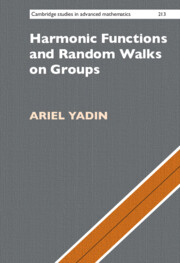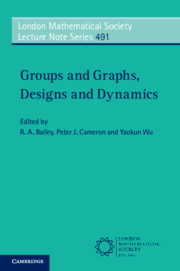Refine search
Actions for selected content:
3044 results in Probability theory and stochastic processes
4 - Networks and Discrete Analysis
- from Part I - Tools and Theory
-
- Book:
- Harmonic Functions and Random Walks on Groups
- Published online:
- 16 May 2024
- Print publication:
- 23 May 2024, pp 117-158
-
- Chapter
- Export citation
2 - Martingales
- from Part I - Tools and Theory
-
- Book:
- Harmonic Functions and Random Walks on Groups
- Published online:
- 16 May 2024
- Print publication:
- 23 May 2024, pp 50-74
-
- Chapter
- Export citation
Appendices
-
- Book:
- Harmonic Functions and Random Walks on Groups
- Published online:
- 16 May 2024
- Print publication:
- 23 May 2024, pp 355-356
-
- Chapter
- Export citation
Appendix A - Hilbert Space Background
-
- Book:
- Harmonic Functions and Random Walks on Groups
- Published online:
- 16 May 2024
- Print publication:
- 23 May 2024, pp 357-364
-
- Chapter
- Export citation
7 - Choquet–Deny Groups
- from Part II - Results and Applications
-
- Book:
- Harmonic Functions and Random Walks on Groups
- Published online:
- 16 May 2024
- Print publication:
- 23 May 2024, pp 246-272
-
- Chapter
- Export citation
Notation
-
- Book:
- Harmonic Functions and Random Walks on Groups
- Published online:
- 16 May 2024
- Print publication:
- 23 May 2024, pp xvii-xx
-
- Chapter
- Export citation
5 - Growth, Dimension, and Heat Kernel
- from Part II - Results and Applications
-
- Book:
- Harmonic Functions and Random Walks on Groups
- Published online:
- 16 May 2024
- Print publication:
- 23 May 2024, pp 161-195
-
- Chapter
- Export citation
Part II - Results and Applications
-
- Book:
- Harmonic Functions and Random Walks on Groups
- Published online:
- 16 May 2024
- Print publication:
- 23 May 2024, pp 159-160
-
- Chapter
- Export citation
References
-
- Book:
- Harmonic Functions and Random Walks on Groups
- Published online:
- 16 May 2024
- Print publication:
- 23 May 2024, pp 374-377
-
- Chapter
- Export citation
Contents
-
- Book:
- Harmonic Functions and Random Walks on Groups
- Published online:
- 16 May 2024
- Print publication:
- 23 May 2024, pp vii-x
-
- Chapter
- Export citation
3 - Markov Chains
- from Part I - Tools and Theory
-
- Book:
- Harmonic Functions and Random Walks on Groups
- Published online:
- 16 May 2024
- Print publication:
- 23 May 2024, pp 75-116
-
- Chapter
- Export citation

Harmonic Functions and Random Walks on Groups
-
- Published online:
- 16 May 2024
- Print publication:
- 23 May 2024

Groups and Graphs, Designs and Dynamics
-
- Published online:
- 11 May 2024
- Print publication:
- 30 May 2024
2 - Moments and Tails
-
- Book:
- Modern Discrete Probability
- Published online:
- 14 December 2023
- Print publication:
- 18 January 2024, pp 21-94
-
- Chapter
- Export citation
Index
-
- Book:
- Modern Discrete Probability
- Published online:
- 14 December 2023
- Print publication:
- 18 January 2024, pp 429-434
-
- Chapter
- Export citation
Appendix B - Measure–Theoretic Foundations
-
- Book:
- Modern Discrete Probability
- Published online:
- 14 December 2023
- Print publication:
- 18 January 2024, pp 398-418
-
- Chapter
- Export citation
4 - Coupling
-
- Book:
- Modern Discrete Probability
- Published online:
- 14 December 2023
- Print publication:
- 18 January 2024, pp 182-255
-
- Chapter
- Export citation
5 - Spectral Methods
-
- Book:
- Modern Discrete Probability
- Published online:
- 14 December 2023
- Print publication:
- 18 January 2024, pp 256-326
-
- Chapter
- Export citation
Contents
-
- Book:
- Modern Discrete Probability
- Published online:
- 14 December 2023
- Print publication:
- 18 January 2024, pp vii-x
-
- Chapter
- Export citation
Bibliography
-
- Book:
- Modern Discrete Probability
- Published online:
- 14 December 2023
- Print publication:
- 18 January 2024, pp 419-428
-
- Chapter
- Export citation
